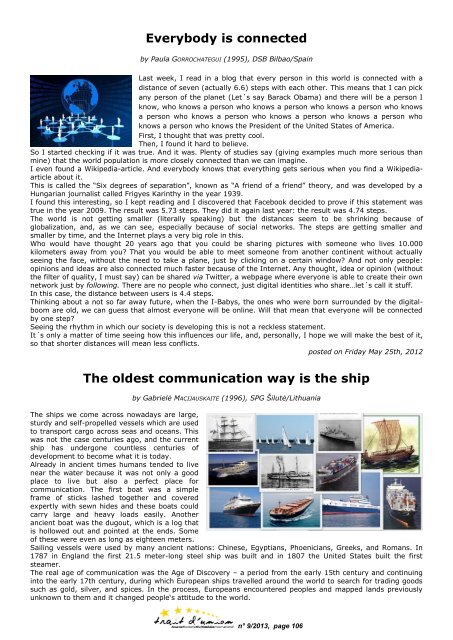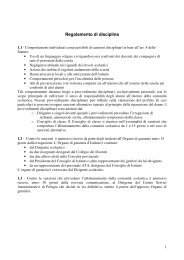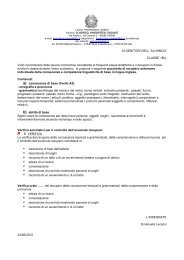Kommunikationsmedien der Wirtschaftby Lu<strong>is</strong>e KAMPS (1995), Svenja HENNING (1995), HPS Buxtehude/GermanyUnsere Welt wird immer schneller!In Deutschland wurden im Jahr 2011 pro Minute etwa 80000 SMS versendet undetwa 80 Prozent der deutschen Haushalte besitzen mittlerweile einen Computer.Elektron<strong>is</strong>che Kommunikationsmedien sind aus unserem Alltag nicht mehrwegzudenken. Doch mit dieser Entwicklung sinken auch die Zahlen derPostsendungen radikal. So <strong>is</strong>t eine Vielzahl der Wirtschaftsunternehmenmittlerweile auf eine elektron<strong>is</strong>che Kommunikation umgestiegen, so auch dashamburg<strong>is</strong>che Unternehmen Heinrich Schütt Stahl KG GmbH& Co. Hier sprachenwir mit dem Abteilungsleiter Tim Henning über „neumod<strong>is</strong>che“ Kommunikation.Es werden Daten vor allem über Computer und Handy und immer weniger überRohrpost und persönliche Gespräche ausgetauscht. So werden Mitteilungen fast ausschließlich per E-Mailverschickt, Kunden und Lieferantendaten werden auf dem Computer gespeichert und auch Wirtschaftszeitungenversuchen sich langsam auf dem elektron<strong>is</strong>chen Markt.Ein Unternehmen kann durch diese Entwicklung viel Zeit und Geld sparen und die Buchhaltung allgemein wirddeutlich einfacher. Dadurch können Arbeitsplätze in diesem Bereich eingespart werden.Im Bereich IT allerdings entstehen neue Arbeitsplätze. Insgesamt lässt sich über die neue Arbeitsverteilungsagen, dass im Durchschnitt 2 neue IT Mitarbeiter eingestellt werden müssen, dafür aber 6 andere Mitarbeiter inder Buchhaltung überflüssig werden. Ebenfalls fällt durch die Nutzung von moderner Datenverarbeitung dieArbeit des Archivierens weg und auch der Bedarf an Büroartikeln wie Papier und Druckerfarbe sinkt. Also <strong>is</strong>t dieelektron<strong>is</strong>che Datenverarbeitung für Unternehmen in jedem Fall von Vorteil!Neben all diesen positiven Entwicklungen für wirtschaftsorientierte Unternehmen gibt es (mittlerweile) aucheinige negative Aspekte. Durch die Nutzung der EDV <strong>is</strong>t der Betrieb be<strong>is</strong>pielswe<strong>is</strong>e sehr stark auf Stromangewiesen. Bei einem Stromausfall <strong>is</strong>t die Produktion und Arbeit der Mitarbeiter gestoppt. Auch kleinste Fehlerin der Elektronik können große Probleme mit sich bringen, die den Betrieb lahm legen.Der wohl wichtigste Punkt gegen die Nutzung der EDV <strong>is</strong>t der Datendiebstahl. Dieser wird auch als „hacken“bezeichnet und geht zurzeit häufig durch die Presse. Gerade die japan<strong>is</strong>che Firma Sony leidet unter starkemDatenraub und musste im Oktober 2011 erklären, dass etwa 93000 Kundendaten gestohlen wurden. Außerdemmussten sie das Netzwerk ihres wohl bekanntesten Produktes, der Play Station, ausschalten. Wie uns die SchüttStahl KG ebenfalls erklärte, können z.B. durch Hacker-Angriffe auch Ideen hinsichtlich Werbestrategiengestohlen werden.Insgesamt zahlt sich die elektron<strong>is</strong>che Kommunikation für Wirtschaftsunternehmen unserer Meinung nach aus,da enorme Kosten eingespart werden können. Trotzdem sollte an der Sicherheit von Kundendaten weitergearbeitet werden, da nur so Vertrauen zw<strong>is</strong>chen Kunden und Unternehmen entstehen kann.by Aleksandra ZIELIŃSKA (1995), 8LO Kraków/PolandJanuary 2012posted on Tuesday, January 17th, 2012Ich stimme mit euch überein, dass Computer und die damit verbundene Elektronik heutzutage eine sehr wichtigeRolle spielen. In der Arbeit wurde der Rechner ein „Helfer“, der grenzenlos zur Verfügung steht und ständigbenutzt wird. Er erleichtert die berufliche Tätigkeit von vielen Angestellten, Beamten und anderen Arbeitern.Auch in Polen <strong>is</strong>t der Bedarf an IT-Arbeitern sehr groß. Wer gute Computerkenntn<strong>is</strong>se hat, kann sofort eingestelltwerden. Dabei kann er ganz gut verdienen. Fast alle Unternehmen, Firmen und Institute basieren aufverschiedenen Computerprogrammen und werden langsam im großen Maße auf elektron<strong>is</strong>che Arbeit umgestellt.Seit einigen Jahren wird die Rekrutierung an der Schule in unserer Stadt elektron<strong>is</strong>ch gemacht. Wahrscheinlichwerden wir im nächsten Schuljahr das elektron<strong>is</strong>che Klassenbuch haben. Wir kommunizieren mit den Lehrernsehr oft per Email, wenn wir diese aus verschiedenen Gründen in der Schule nicht erreichen können. DerDeutsch- und Engl<strong>is</strong>chunterricht in unserer Klasse umfasst auch die Arbeit auf der Plattform trait d’union. Ichpersönlich benutze sehr oft oder -laut meiner Mutter- zu oft sowohl den Computer als auch das Mobiltelefon, undnicht nur für die Schule.Ich habe schon geschrieben, dass die Elektronik vielen Leuten eine Arbeitsstelle „verschafft“. Dies hat jedochnoch eine zweite Seite. Weil die Arbeit mit dem Computer modern<strong>is</strong>iert <strong>is</strong>t und immer mehr Polen viele Sachenper Internet erledigen, werden zahlreiche Bank-, Post- und Behördenangestellte und –beamte arbeitslos. MeineGroßeltern sagen, dass der Computer die Welt beherrscht, und der Mensch sein „Sklave“ <strong>is</strong>t. Haben sie recht?Die Hacker – das <strong>is</strong>t das nächste Argument, das gegen das Archivieren im Internet spricht. Trotzdem machendas viele poln<strong>is</strong>che Firmen, weil das erstens bei uns in Mode <strong>is</strong>t und die Kosten deutlich verringert.Euer Artikel hat mich zum Nachdenken provoziert, was passieren könnte, wenn wir unsere Wirtschaft und dieganze Arbeitswelt den modernden Kommunikationsmedien gedankenlos ganz und gar anvertrauen würden.Menschliche Beziehungen und gesellschaftliche Kontakte geraten sicher in Vergessenheit, und die Gefühle undEmotionen, die man auch in der Arbeit pflegen soll, verlieren an Wert. Meiner Meinung nach sollte man dasgenau überlegen, gew<strong>is</strong>se Grenzen bestimmen und die beste Lösung finden, um die Gefahren, die dievollständige Computer<strong>is</strong>ierung des menschlichen Lebens mit sich mitbringt, zu vermeiden. Ist das überhauptnoch möglich?n° 9/2013, page 105
Everybody <strong>is</strong> connectedby Paula GORROCHATEGUI (1995), DSB Bilbao/SpainLast week, I read in a blog that every person in th<strong>is</strong> world <strong>is</strong> connected with ad<strong>is</strong>tance of seven (actually 6.6) steps with each other. Th<strong>is</strong> means that I can pickany person of the planet (Let´s say Barack Obama) and there will be a person Iknow, who knows a person who knows a person who knows a person who knowsa person who knows a person who knows a person who knows a person whoknows a person who knows the President of the United States of America.First, I thought that was pretty cool.<strong>The</strong>n, I found it hard to believe.So I started checking if it was true. And it was. Plenty of studies say (giving examples much more serious thanmine) that the world population <strong>is</strong> more closely connected than we can imagine.I even found a Wikipedia-article. And everybody knows that everything gets serious when you find a Wikipediaarticleabout it.Th<strong>is</strong> <strong>is</strong> called the “Six degrees of separation”, known as “A friend of a friend” theory, and was developed by aHungarian journal<strong>is</strong>t called Frigyes Karinthy in the year 1939.I found th<strong>is</strong> interesting, so I kept reading and I d<strong>is</strong>covered that Facebook decided to prove if th<strong>is</strong> statement wastrue in the year 2009. <strong>The</strong> result was 5.73 steps. <strong>The</strong>y did it again last year: the result was 4.74 steps.<strong>The</strong> world <strong>is</strong> not getting smaller (literally speaking) but the d<strong>is</strong>tances seem to be shrinking because ofglobalization, and, as we can see, especially because of social networks. <strong>The</strong> steps are getting smaller andsmaller by time, and the Internet plays a very big role in th<strong>is</strong>.Who would have thought 20 years ago that you could be sharing pictures with someone who lives 10.000kilometers away from you? That you would be able to meet someone from another continent without actuallyseeing the face, without the need to take a plane, just by clicking on a certain window? And not only people:opinions and ideas are also connected much faster because of the Internet. Any thought, idea or opinion (withoutthe filter of quality, I must say) can be shared via Twitter, a webpage where everyone <strong>is</strong> able to create their ownnetwork just by following. <strong>The</strong>re are no people who connect, just digital identities who share…let´s call it stuff.In th<strong>is</strong> case, the d<strong>is</strong>tance between users <strong>is</strong> 4.4 steps.Thinking about a not so far away future, when the I-Babys, the ones who were born surrounded by the digitalboomare old, we can guess that almost everyone will be online. Will that mean that everyone will be connectedby one step?Seeing the rhythm in which our society <strong>is</strong> developing th<strong>is</strong> <strong>is</strong> not a reckless statement.It´s only a matter of time seeing how th<strong>is</strong> influences our life, and, personally, I hope we will make the best of it,so that shorter d<strong>is</strong>tances will mean less conflicts.posted on Friday May 25th, 2012<strong>The</strong> oldest communication way <strong>is</strong> the shipby Gabrielė MACIJAUSKAITĖ (1996), SPG Šilutė/Lithuania<strong>The</strong> ships we come across nowadays are large,sturdy and self-propelled vessels which are usedto transport cargo across seas and oceans. Th<strong>is</strong>was not the case centuries ago, and the currentship has undergone countless centuries ofdevelopment to become what it <strong>is</strong> today.Already in ancient times humans tended to livenear the water because it was not only a goodplace to live but also a perfect place forcommunication. <strong>The</strong> first boat was a simpleframe of sticks lashed together and coveredexpertly with sewn hides and these boats couldcarry large and heavy loads easily. Anotherancient boat was the dugout, which <strong>is</strong> a log that<strong>is</strong> hollowed out and pointed at the ends. Someof these were even as long as eighteen meters.Sailing vessels were used by many ancient nations: Chinese, Egyptians, Phoenicians, Greeks, and Romans. In1787 in England the first 21.5 meter-long steel ship was built and in 1807 the United States built the firststeamer.<strong>The</strong> real age of communication was the Age of D<strong>is</strong>covery – a period from the early 15th century and continuinginto the early 17th century, during which European ships travelled around the world to search for trading goodssuch as gold, silver, and spices. In the process, Europeans encountered peoples and mapped lands previouslyunknown to them and it changed people‘s attitude to the world.n° 9/2013, page 106
- Seite 1 und 2:
traitdunion-online.eutraitdunion-on
- Seite 3 und 4:
The Participaiting schools:Coordina
- Seite 5 und 6:
Aleksandra CIOŚ, Aleksandra ZIELI
- Seite 7 und 8:
Sara VANTAGGI (LSP): The power to b
- Seite 9 und 10:
I. My national and European identit
- Seite 11:
14. Do you usually take part in typ
- Seite 14 und 15:
n° 9/2013, page 13
- Seite 16 und 17:
National and European identity: the
- Seite 18 und 19:
Italy: the history of a cultureItal
- Seite 20 und 21:
Interview with four different peopl
- Seite 22 und 23:
Kommentar zum Artikel “Die italie
- Seite 24 und 25:
y Marta ZERBINI (1994), LSP Assisi/
- Seite 26 und 27:
In our school we have found four st
- Seite 28 und 29:
Feeling guilty and abject seemed to
- Seite 30 und 31:
Youth culture: then and nowby Marle
- Seite 32 und 33:
In former times, young people would
- Seite 34 und 35:
Eine Jugend in der Nachkriegszeitby
- Seite 36 und 37:
Gender Roles - Then and Nowby Laura
- Seite 38 und 39:
Another place where you might spot
- Seite 40 und 41:
My grandfather also had to help his
- Seite 42 und 43:
Wer schreibt nicht zumindest ein pa
- Seite 44 und 45:
Den meisten Jugendlichen, die wir k
- Seite 46 und 47:
Nun stand sie vor verschlossener T
- Seite 48 und 49:
Lernen mit dem Lehrbuch in der Hand
- Seite 50 und 51:
Education in Polandby Anna MACHNIK
- Seite 52 und 53:
y Katarzyna LENAR (1995), 8LO Krak
- Seite 54 und 55:
Comparing English Teachersby Selay
- Seite 56 und 57: Different countries, same difficult
- Seite 58 und 59: And what would you say about your c
- Seite 60 und 61: Während der dreitätigen Beratunge
- Seite 62 und 63: Projektproblematikby Bożena CUDAK,
- Seite 64 und 65: Während des 1. Weltkrieges wurden
- Seite 66 und 67: General living conditions - Contrib
- Seite 68 und 69: „Frania”by Monika ŻABA (1995),
- Seite 70 und 71: Der Motor befand sich im hinteren T
- Seite 72 und 73: In der mittleren Generation kam die
- Seite 74 und 75: y Aleksandra CIOŚ (1995), 8LO Krak
- Seite 76 und 77: Differently from your city, Assisi
- Seite 78 und 79: Im Herbst 2011 wurde im Freien auf
- Seite 80 und 81: Leben in der stetigen Angstby Aleks
- Seite 82 und 83: y Tomasz SAŁEK (1995), 8LO Kraków
- Seite 84 und 85: Man konnte natürlich nur den Fiat
- Seite 86 und 87: There are lots of different opinion
- Seite 88 und 89: Margot MASCI (1994), LSP Assisi/Ita
- Seite 90 und 91: Die Leute hatten kein Privatleben.
- Seite 92 und 93: Umbria: Life in the pastby Marta ZE
- Seite 94 und 95: Heute können aber die Passanten ru
- Seite 96 und 97: Ist die Emigration ein guter Ausweg
- Seite 98 und 99: KommunikationsmedienMedia of Commun
- Seite 100 und 101: • Information published through t
- Seite 102 und 103: For example when we were younger ou
- Seite 104 und 105: Ein Interview mit der Klassenlehrer
- Seite 108 und 109: Shipping in ŠilutėA famous fish m
- Seite 110 und 111: To find out the answers to these qu
- Seite 112 und 113: The latest one even talks to you li
- Seite 114 und 115: VI.A sound mind in a sound bodyIn e
- Seite 116 und 117: y Monika TOMCZOK (1995), 8LO Krakó
- Seite 118 und 119: Trendsportarten wie Yoga und Zumba
- Seite 120 und 121: We are proud of our basketball and
- Seite 122 und 123: Exercise helps, but it should be do
- Seite 124 und 125: CURRENT AFFAIRS AND TRENDSARE CHANG
- Seite 126 und 127: The world is changing: Cyber relati
- Seite 128 und 129: The following facts are at the same
- Seite 130 und 131: In vielen Kinofilmen wird uns gezei
- Seite 132 und 133: Many people have done, like for exa
- Seite 134 und 135: In der Praxis wird die Rechtsstellu
- Seite 136 und 137: For instance I believe that phones,
- Seite 138 und 139: The future might bring…by Deivida
- Seite 140 und 141: y Annika PETERS (1997), HPS Buxtehu
- Seite 142 und 143: Since I can remember, fictional sto
- Seite 144 und 145: Nowadays we feel as if the vote is
- Seite 146 und 147: Do we really respect human rights?b
- Seite 148 und 149: Um diese Angriffe zu vermeiden ist
- Seite 150 und 151: Verloren in der Weltby Eleonora PAN
- Seite 152 und 153: y Anna BRANDL (1995), BORG Krems/Au
- Seite 154 und 155: The happiness of lifeby Aurelija ZA
- Seite 156 und 157:
Growing up: ready to take the risk?
- Seite 158 und 159:
11 März 2004. Bombenanschlag in Ma
- Seite 160 und 161:
Am nächsten Tag wollten sie plötz
- Seite 162 und 163:
n° 9/2013, page 161
- Seite 164 und 165:
How youth changes the worldby Catal
- Seite 166 und 167:
How Do Young People Change The Worl
- Seite 168 und 169:
Schüler von VIII LO Kraków gestal
- Seite 170 und 171:
Me and my friends…What influences
- Seite 172 und 173:
y Anna MACHNIK (1995), 8LO Kraków/
- Seite 174 und 175:
Im 200-Jubiläumsjahr von weltbekan
- Seite 176 und 177:
The last one I choose is bythe Poli
- Seite 178 und 179:
Now I’m in high-school. I changed
- Seite 180 und 181:
Von B nach B (Bamberg - Bilbao)Ein
- Seite 182 und 183:
SchoolAnna P: I learn new things fr
- Seite 184 und 185:
Da fanden wir ihn im Bett schlafend
- Seite 186 und 187:
d) As you can guess, my appearance
- Seite 188 und 189:
Ich denke, dass das von die genannt
- Seite 190 und 191:
In conclusion, I want to saythat re
- Seite 192 und 193:
Sometimes, I’m a good example of
- Seite 194 und 195:
Qual der Wahlby Monika ŻABA (1995)
- Seite 196 und 197:
And, of course, one ofthe greatest
- Seite 198 und 199:
Jetzt wo wir wieder zu Hause sind,
- Seite 200 und 201:
The Comenius poemby Jacqueline CLEV
- Seite 202 und 203:
n° 9/2013, page 201posted on Frida
- Seite 204 und 205:
The future might bring…by Deivida
- Seite 206 und 207:
Diese Diskussion wird meiner Meinun
- Seite 208 und 209:
Von der zukünftigen Medizin erwart
- Seite 210 und 211:
In the social sphere there are clea
- Seite 212 und 213:
y Lea STÖHLKER (1996), HPS Buxtehu
- Seite 214 und 215:
Deine Stunde für unseren PlanetenK
- Seite 216 und 217:
Stephans persönliches Urteil ist,
- Seite 218 und 219:
Als ich in ihrem Alter war, haben a
- Seite 220 und 221:
Diese Musikrichtung oder Gattung wi
- Seite 222 und 223:
n° 9/2013, page 221
- Seite 224 und 225:
Als nächstes sollte man verhindern
- Seite 226 und 227:
Oder wollt ihr euch denn UNBEDINGT
- Seite 228 und 229:
Newer and newer systems give studen
- Seite 230 und 231:
Kommentar zum Artikel von Lea Stöh
- Seite 232 und 233:
Schluss mit der Unterdrückung der
- Seite 234 und 235:
Reduce. Reuse. Recycle. Das war das
- Seite 236 und 237:
y Veronika DOUJAK (1996), BORG Krem
- Seite 238 und 239:
Die damit verbundenen aber meist ho
- Seite 240 und 241:
ImprintSchools and Names in alphabe
- Seite 242:
n° 9/2013, page 241






